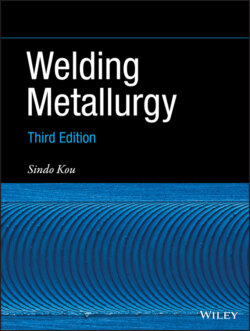Читать книгу Welding Metallurgy - Sindo Kou - Страница 27
1.3.2.2 Polarity
ОглавлениеFigure 1.13 shows three different polarities in GTAW [5], which are described next:
1 Direct‐current electrode negative(DCEN). This, also called the straight polarity, is the most common polarity in GTAW. The electrode is connected to the negative terminal of the power supply. As shown in Figure 1.13a, electrons are emitted from the tungsten electrode and accelerated while traveling through the arc. A significant amount of energy, called the work function, is required for an electron to be emitted from the electrode. When the electron enters the workpiece, an amount of energy equivalent to the work function is released. This is why in GTAW with DCEN more power (about two‐thirds) is located at the workpiece end of the arc and less (about one‐third) at the electrode end. Consequently, a relatively narrow and deep weld can be produced.
2 Direct‐current electrode positive(DCEP). This is also called the reverse polarity. The electrode is connected to the positive terminal of the power source. As shown in Figure 1.13b, the heating effect of electrons is now at the tungsten electrode rather than at the workpiece, thus producing a shallow weld. Furthermore, a large‐diameter, water‐cooled electrode is preferred in order to prevent the electrode tip from melting. The positive ions of the shielding gas bombard the workpiece, as illustrated in Figure 1.14, knocking off oxide films and producing a clean weld surface. Therefore, DCEP can be used for welding thin sheets of strong oxide‐forming materials such as aluminum and magnesium, where deep penetration is not required.
3 Alternating current (AC). Reasonably good penetration and oxide cleaning action can both be obtained, as illustrated in Figure 1.13c. This is often used for welding aluminum alloys.
Figure 1.13 Three different polarities in GTAW.
Figure 1.14 Surface cleaning action in GTAW with DC electrode positive.
